Gartner Magic Quadrant for DXP 2021 Review
CMS-Connected Media Corp. is pleased to bring you exclusive coverage of the Gartner Magic Quadrant for DXP 2021. As with our other Gartner reviews, our write-ups feature exclusive interviews and comments directly from the vendors represented in the Gartner MQ.
Gartner considers a digital experience platform (DXP) to be a “well-integrated and cohesive set of technologies designed to enable the composition, management, delivery, and optimization of contextualized digital experiences across multi-experience customer journeys.” According to Gartner, the essential capabilities of a DXP should include content management, account services, personalization, customer data management, cloud capabilities, and AI, just to name a few.
The report evaluates the vendors' ability to execute, through product or service offerings, viability, sales channel, responsiveness, marketing execution, customer support and experience, and overall organizational effectiveness. The report also considers the “completeness of vision” of the vendor by evaluating their sales and marketing strategy, innovation, business model, product, industry, and regional strategies.
The report was authored by Gartner's Irina Guseva, Mick MacComascaigh, and Mike Lowndes. This year’s Magic Quadrant features sixteen of the most important vendors and providers of digital experience platforms.
CMS-Connected wishes to thank all of the Gartner MQ DXP 2021 vendor representatives who took the time to participate in our review. The viewpoints provide a unique perspective and a valuable wealth of knowledge and resource to those who are interested in exploring the DXP market space.
Click our link to receive a free copy of the Gartner Magic Quadrant for Digital Experience Platforms 2021.
| 2020 Gartner Magic Quadrant for DXP |
2021 Gartner Magic Quadrant for DXP |
|
|
|
Click images above to enlarge |
Leaders (Adobe, Acquia, Optimizely (Episerver), Sitecore, Liferay)
Adobe
Adobe is in the lead for another year with its Adobe Experience Cloud. According to Gartner, Adobe’s strengths are its extensive ecosystem of implementation and strategy partners, “differentiations customer data management capabilities,” and strong brand recognition. The report suggests Adobe has some of the highest total cost ownership on the market, a complex implementation process, and limited use for B2B accounts. CMS-Connected was unable to schedule an interview with Adobe in time for our article publication.
Acquia
Acquia leads the Quadrant for another year thanks to its open DXP approach, its extensive contributor community, and its strategic acquisitions and investments. Acquia’s services are suitable for B2C and B2B, as well as customers in the financial, manufacturing, and government sectors. The report indicates that Acquia falls short in personalization capabilities compared to its competitors, has a limited number of technology partners, and confusing overlap capabilities between the Drupal and Marketing Cloud.
Interviewee: Eric Fullerton, Lead Product Evangelist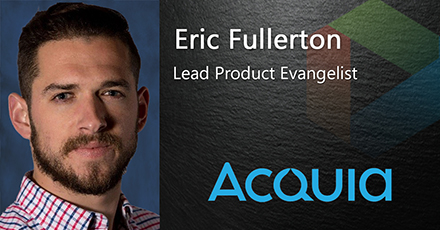
Acquia has been named as a Leader in the 2021 edition of the Gartner MQ DXP report. What is Acquia doing to continuing holding this position? What does it take to be a Leader?
“Acquia's Open DXP is focused on helping CIOs and CMOs accelerate the pivot to digital with its Drupal Cloud and Marketing Cloud offerings. For Drupal Cloud, Acquia is focused on building a worldwide community of developers to build, share, and maintain reusable application and integration modules to enable rapid assembly, configuration, and deployment of new digital products, services, and experiences. In addition, Acquia is focused on building a worldwide community of digital marketers and digital agencies to build, share, and maintain reusable presentation components, design elements, and design systems to enable rapid authoring, composition, and design optimization of multiexperiences.
"Acquia's Marketing Cloud builds on this community of digital marketers and digital agencies by providing a platform for rapid data integration, real-time customer analytics, and application of predictive machine-learning models to personalize and orchestrate customer journeys at scale with the next-best-content, next-best channel, next-best action, and next-best experience for each unique user. For CIO's and CMO's, Acquia also enables the creation of centrally governed digital stacks to templatize digital experiences across both IT and Marketing — content, application logic, presentation, design, data, models, customer journeys, multi-channel campaigns - to accelerate time to market for new B2C, B2B, and B2E experiences, all with built-in, best-in-class, security, compliance, and governance.”
What differentiates the Acquia platform from its competitors?
“Openness — Acquia's core heritage is open source and open communities. The core tenets of openness apply to all aspects of product strategy, development, and GTM. For Drupal Cloud, openness is core to digital velocity and driving faster innovation cycles across IT and Marketing. The five core elements of openness include:
1. Access to a worldwide community of open source developers to crowdsource pre-built integrations to unlock content and application services from back-end systems.
2. Open architecture to rapidly create, share, and reuse lightweight application modules to deliver new digital services in the context of any experience.
3. Open-content modeling to define core content architecture, metadata, and reusable elements to support reuse across sites, applications, and organizations through federated search and syndication.
4. Open experience modeling to define core design systems, components, and reusable elements to support rapid composition of multi-experiences and multi-experience journeys from set of pre-build, pre-approved standards.
5. Open digital stacks to define core templatized experiences combining integration modules, application modules, content and experience models into standardized business use cases that can be rapidly replicated and provisioned to the business (for example, a standardized B2C commerce site that can centrally built and provisioned across brands and regional operating entities).
Data-first — Acquia Marketing Cloud puts customer data and data-science at the core of the digital experience. The starting point for Acquia's Marketing Cloud is first and foremost to gain a 360-degree view of the customer, analyze and understand their profile, behavior, and intent, and then map specific desired outcomes to an orchestrated journey. Acquia Marketing Cloud breaks the activation-first model of channel or touchpoint-specific systems that lead to data silos and inability to derive actionable, data-driven insights across the customer lifecycle to optimize the customer journey against specific desired outcomes. With CDP at the core, all Acquia campaigns and touchpoints can be personalized at scale to deliver next-best experience.
Content-first — Acquia Drupal Cloud puts content and content-driven applications at the core of the digital experience. The starting point for Acquia's Drupal Cloud is first and foremost to define the core content architecture and content models to support a consistent customer experience across all organizational and digital touchpoints. Acquia's Drupal Cloud breaks the separations between content and applications and enabling organizations to mobilize and reuse content across all assembled digital applications and experiences, from marketing customer acquisition sites, to customer mobile apps, to supporting agent experiences, and more.”
What do you think about the challenges presented in the report? How does Acquia plan to address them?
“Not only do we have plans to address these challenges, since our submission was back in November of 2020, we have already made significant progress on these initiatives. The challenges, and our response to each, is below:
- Potential confusion and overlap between Acquia’s Drupal and Marketing Clouds: Much of this overlap, we believe, is tied to Acquia Personalization, which is part of Marketing Cloud but a saleable add-on to Drupal Cloud. Personalization sold stand-alone today with Drupal Cloud maintains its own data and analytics separate from CDP. Our recent unification of data and analytics across Personalization, CDP, and the remainder of the Marketing Cloud should address this in our 2022 submission. That said, since our submission, we have already made progress turning this into a strength for 2021. Personalization is now bundled as part of our Drupal Cloud Core+ offering. Personalization is now integrated with Acquia Site Studio on the front end and Acquia CDP on the back end with bundled services as part of the Core+ package to ensure customer success.
- Personalization as a weakness: We are turning this area of weakness into a strength — 2021 is the Year of the CDP. Our personalization engine sites atop our CDP with shared data on the back end. Standalone, siloed martech tools are no longer sufficient to gain true data intelligence. 2020 taught us that a robust personalization strategy is a requirement for success in 2021. We believe this will be reflected in our 2022 submission.
- Our 'open' positioning feels like a contrast to our small number of actual tech partnerships: We are currently working to address this with a number of partners in the DX alliance, and several are already in the works (Lucidworks, CommerceTools, etc.). While that number is still small, our ecosystem is the full Drupal ecosystem and the powerful integrations made possible by open source technology.”
What are Acquia's plans for the digital experience space in the coming year?
“Acquia is focused on delivering value to our customers across our entire product portfolio. Our recent product launch includes new product releases as well as updated capabilities across both Drupal Cloud and Marketing Cloud.
Drupal Cloud
- Acquia CMS (New): A new, out of the box, fully functional distribution of Drupal, curated by Acquia
- Acquia Migrate (New): A new solution that helps organizations accelerate migration to Drupal 9 by up to 80% faster for all D7 sites
- Acquia Site Studio (Improved): An improved visual page builder and a new UI Kit with 70 pre-built solutions to enable marketers to build complex pages using a visual drag and drop interface, no coding required.
- New Acquia Cloud Platform (Improved): Next-generation hosting with auto-scaling, self-healing, and performance improvements
Marketing Cloud
- Unified Analytics across Acquia Marketing Cloud (New): Insights to inform smart website personalization strategy (& increased revenue) based on unified CDP data
- Machine Learning Models (New): Predictive intelligence to help marketers better understand their customers and engage with them in ways they want, including new predictive send models and fuzzy clustering models so that customers can be classified into multiple segments.
- Campaign Performance Reporting (Improved): Predictive intelligence to help marketers better understand their customers and engage with them in ways they want, including segment-level campaign reporting via Cohort Analysis
- Privacy Compliance (Improved): Increased efficiency when honoring customer record deletion requests, including self-serve compliance for GDPR/CCPA deletion requests and a new data erasure request available via both UI and API.
Beyond product releases, Acquia’s focus for 2021 and beyond is to help organizations deliver on the promise of the Composable Enterprise. What is required for a company to adopt the 'Composable Enterprise?' First, it starts with the right architecture. It’s open, flexible, connected, and fast. The 'Composable Enterprise' is a set of digital services that can be assembled and delivered quickly and easily. It’s driven by the CIO and Enterprise Architect providing a set of packaged services to the business. Second, it requires a new way of thinking, driven by marketing or the CMO. The CMO recognizes that speed is one of their biggest differentiators, so organizing their teams to assemble customer experiences that connect content and data — on whatever channel customers are engaged — is going to drive brand awareness and MQLs. They are no longer thinking about channels, they are thinking about customers and how to make a meaningful connection. Third, the concept of 'Composable' needs to be governed so the risk and security needs are adhered to, as directed by the CISO.”
Optimizely (Episerver)
Episerver, now Optimizely, experienced a slight dip in the Leader quadrant but continues to lead thanks to its solid grasp of the DXP market and strategic acquisitions like Idio and Optimizely. Strong marketing, competitive pricing, and modular packaging are some of the factors that contributed to its position this year. The report's cautions for the vendor are its lack of B2B and B2E focus in product offering and shifts in ownership and leadership. CMS-Connected was unable to schedule an interview with Optimizely in time for article publication.
Sitecore
Sitecore continues to hold on to the Leader position for another year thanks to its Sitecore Experience Platform. Its strengths include a broad set of digital experience capabilities, adequate response to market demands, and increased expansion in areas such as AI and Machine Learning capabilities. The cautions include “monolithic” pricing, lack of “differentiated capabilities” in certain areas, and customers' struggles to use the software fully.
Interviewee: Matt Krebsbach, VP of Strategic Messaging & Communications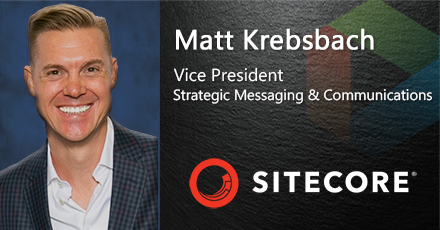
Sitecore has been named as a Leader in this year’s edition of the Gartner MQ DXP report. What is Sitecore doing to continue holding this position? What does it take to be a Leader?
“This is the fourth year in a row that Sitecore has been named a Leader in the DXP MQ, not to mention our ten consecutive years as a Leader in the Web Content Management market, which was a forerunner to and now a sub-segment of DXP. Gartner’s own definition in the DXP MQ sums up what that takes: 'Leaders have ample ability to support a variety of DXP use cases and consistently meet customers’ needs over substantial periods. Leaders have delivered significant product innovation in pursuit of DXP requirements and have been successful in selling to new customers across industries.' That’s why we’ve been at the forefront of this space longer than any of our competitors. But there’s no complacency at Sitecore, just a team that is energized and determined to consistently deliver solutions that enable our customers to stay ahead of complex, fast-changing digital experience trends.”
What differentiates the Sitecore platform from its competitors?
“One of the trends Gartner highlighted in the DXP MQ is the tug of war between vendors who have assembled vast technology portfolios versus those who cover a smaller part of the DXP technology landscape. But both complicate an organization’s ability to deliver superior, contextually relevant experiences to their customers at every touchpoint. Sitecore fits neatly in the middle by design. We offer the digital experience management technologies necessary to plan, create, orchestrate, optimize, and drive revenue from customer-focused digital experiences, but that doesn’t mean that we are today or will ever be everything to everybody. That focus means we can offer our customers all of the technologies that are fundamental to earning their customers’ business and loyalty, as well as the benefits of an integrated, flexible, and connectable platform that enables them to quickly adapt to changing business demands with less risk to their business.”
What do you think about the challenges presented in the report? How does Sitecore plan to address them?
“Every Magic Quadrant includes some constructive feedback, and we’re always listening to the community — whether that’s our customers and partners or the analysts who cover us — to continually improve the products we build and the ways we do business. Between the evaluation and the publication of the DXP MQ, we’ve made marked progress in several areas directly related to Gartner’s assessment, including a significant expansion of our customer success organization and modifications to our sales operations. In addition, several developments that followed shortly after publication of the MQ should give readers plenty of reason to look beyond the graphic, in particular. Notably, Gartner’s evaluation doesn’t account for the impact of the $1.2 billion investment that will fuel our growth plan and accelerated product innovation, much less our acquisitions of Boxever, provider of a SaaS-based CDP, and B2B and B2C commerce company Four51. Altogether, the steps we’ve taken in just the past few months will increase the value of our customers’ investments in Sitecore and accelerate our ability to offer a fully integrated, SaaS-based digital experience platform. And we’re just getting started.”
What are Sitecore's plans for the digital experience space in the coming year?
“As I mentioned earlier, we’ve had a massive capital investment of $1.2 billion, and we’re wholly focused on turning that into unmatched ROI for the companies who use Sitecore solutions to create, deliver, and drive revenue from exceptional customer experiences. Our goal is to not only offer a flexible, scalable, and feature-rich platform but also to free our customers from managing the underlying technology so they can get maximum value with minimal effort. This means we’ll continue to invest in the development of cloud-native, API-first, and modular technologies that offer faster innovation, less upfront investment, and shorter time to value. It also means we’ll continue to adapt our business to be more agile, collaborative, and transparent for our customers and partners. For every step we take to reduce the effort to implement and deploy our solutions, our customers gain an outsized benefit in cost and actionability for their customer experience initiatives.”
Liferay
Holding its place in the Leader category for another year, Liferay gets praise for its “platform for authenticated customer and partner portal use cases”, extensibility, integration, decoupled and headless presentation, and generally good value for money. The cautions include lack of a mature extensibility model, confusing pricing and packaging of certain offerings, and a focus on serving the B2B market.
Interviewee: Darren Sepanek, Head of Global Partner Marketing 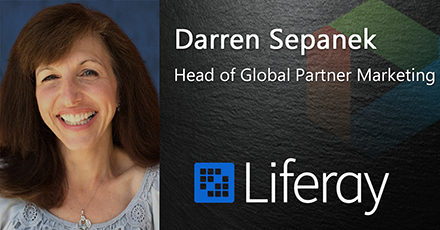
Liferay has been named as a Leader in this year’s edition of the Gartner MQ DXP report. What is Liferay doing to continue holding this position? What does it take to be a Leader?
“What we are doing to sustain our position as a Gartner MQ DXP leader and what it takes to be a leader can be answered with the same response: Focusing on what our clients need while also staying on top of the technology curve. This requires a careful balance. The latest in technology isn’t always what clients need and want, while to maintain our position as a technology leader, we must predict what clients will want and what will be best to meet their business challenges.
"In order to maintain our leadership position, we are constantly evolving our platform and delivery models based on the needs of our target audiences. We are also strengthening our partner ecosystem so that they can play an even greater role in serving our vast client base with the solutions these clients need.”
What differentiates the Liferay platform from its competitors?
“First, we are the only vendor to be recognized as a leader for DXPs in the Gartner MQ for 11 years straight — far longer than any other vendor. We are an open-source platform that has been built from within from the beginning, while many of our competitors have gone through acquisitions and add-ons of technology that may or may not have benefitted their final outcome.
"Liferay is typically seen as a good value, and Gartner agrees with this. The TCO of a Liferay solution is generally lower than that of our primary competitors. We are particularly proud of the fact that it’s not just that we have competitive pricing, but that we offer considerable value to our clients.
"One of the best ways to evaluate Liferay’s capabilities versus that of our competitors is to read this year’s edition of Gartner’s Critical Capabilities for Digital Experience Platforms. For the second consecutive year, Liferay is the highest-rated vendor for both B2B and B2E use cases (we were also the highest-rated vendor in these scenarios in the 2020 report).
"Furthermore, we improved our scores in 10 functionality categories compared to last year and received even higher scores than in 2020 in all three use case categories: B2B, B2C, and B2E.
"For readers not familiar with the Critical Capabilities (CC) report — these were designed as a response to criticism that the Magic Quadrant analysis provides a -'one size fits all' view of the market and does not take into account the needs of specific use cases.
"The CC reports rank vendors according to their fit for specific Gartner-defined use cases. In the case of the DXP CC, these use cases are 'B2B,' 'B2C,' and 'B2E.' Rankings are determined by vendors’ composite scores in various areas of functionality (e.g., 'Cloud Support' and 'Extensibility & Integration') multiplied by a Gartner’s weighting of each area of functionality by use case. For example, in this year’s CC report, 'Analytics & Optimization' was weighted at 15% for the B2C use case but just 5% for the B2B use case.
"Our leading scores in the CC report speak volumes to how well we serve our clients with our technology and services.
"From the report, 'Liferay can address all use cases but ranks best for B2B, and is most often deployed by large B2B/business to business to business or consumer (B2B2X), and public sector organizations building customer or partner portals. Liferay also ranked highest by a wide margin for the B2E use case.'
What do you think about the challenges presented in the report? How does Liferay plan to address them?
“One of the few areas of weakness noted for Liferay is that we are used for authenticated B2B experiences and lack content management, personalization, and digital marketing features that Gartner deems a requirement for advanced B2C scenarios.
"While exceptionally strong in B2B and B2E use cases, we find Liferay is used often for B2C in our customer portal solutions. Functionality for marketing-driven B2C use cases accounted for the majority of development efforts in our last three releases of Liferay DXP, including the addition of Master Pages for more streamlined content creation and deep content performance analytics in our latest release. We continue to develop functionality that can be used for customer self-service portals including much-desired personalization capabilities.”
What are Liferay's plans for the digital experience space in the coming year?
“The digital experience market is continually evolving, and as a company and as a platform, we will continue to evolve with it. A core component of that evolution is continuing to understand our clients and what they need and are looking for in a digital experience platform. One of our most notable plans for 2021 is that we are applying even greater focus on providing expertise and solutions for the insurance, finance/banking/wealth management, and manufacturing verticals, which includes self-service and B2B Commerce solutions. This by no means infers that we are limiting ourselves to these areas, and along with our partners, we will continue to address the needs and use cases of a wide range of other verticals. The focus in these three verticals is to better address the need for Liferay to have an even greater impact on the business challenges facing these industries.”
Visionaries (Bloomreach)
Bloomreach
Bloomreach hold its place in the Visionary Quadrant for another year thanks to its advanced headless support through a full GraphQL API, a robust search, product discovery and merchandising offerings, and a customer-focused approach. The report’s cautions include Bloomreach's limited strategy emphasis on mostly commerce, slow growth, and a small partner ecosystem.
Interviewee: Brian Walker, Chief Strategy Officer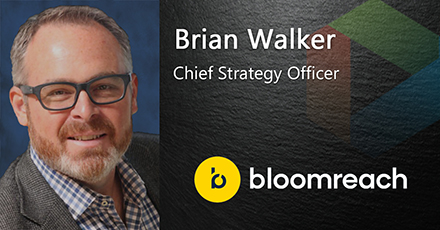
What do you think earned Bloomreach a spot in this year’s Magic Quadrant DXP report?
“Bloomreach is unique as a solution in the DXP Magic Quadrant in a few key ways. First, our focus on digital commerce businesses' unique needs to drive optimized experiences that deliver business results at scale, and the need for a composable and modular platform built on artificial intelligence and delivered through powerful APIs. That, in Gartner’s view, adds up to a visionary in the DXP market, and we could not agree more.”
What differentiates the Bloomreach platform from its competitors?
“Bloomreach's strong focus on data and AI is its primary differentiator and plays a role in why we are able to dominate in the commerce market. There is no DXP that understands product data better than Bloomreach, and now with the acquisition of Exponea, no DXP that understands customers better. By integrating these two data powerhouses, Bloomreach will be able to serve marketers and digital professionals with the full spectrum of commerce data they need to build winning experiences.”
What do you think about the challenges presented in the report? How does Bloomreach plan to address them?
“The report is looking at the state Bloomreach was at in 2020 before we added the strengths that came from the Exponea acquisition and our common synergies and market presence. Some of the general cautions in the report were also not applicable to Bloomreach as we had a spotless record of availability and performance built upon our multi-tenant SaaS solutions — unlike many DXP competitors who offer single-tenant solutions that are not as scalable as ours.”
What are Bloomreach's plans for the digital experience space in the coming year?
“Bloomreach remains focused on providing a modular, API-first Digital Experience platform for digital business and marketing. We have a lot of investment planned across our content, product discovery, and customer engagement product areas in 2021.”
Challengers (Salesforce, Oracle, OpenText, HCL Software)
Salesforce
This year finds Salesforce in the Challenger quadrant once again, thanks to its Salesforce Experience Cloud. The reports’ strengths include the breadth of CRM capabilities, industry-specific focus, and advanced segmentation capabilities. The cautions touch on the potential for increased costs due to the fact that Salesforce’s DXP is often used in conjunction with other products offered by the vendor. The CMS feature lacks certain capabilities compared to other vendors, and the overall price can prove inaccessible for smaller organizations. CMS-Connected was unable to schedule an interview with Salesforce in time for article publication.
Oracle
With Gartner naming Oracle as a Challenger once again, the Oracle Customer Experience gets recognition for its global presence and partner ecosystem, their “pageless experiences,” and user interface. Gartner’s cautions include a narrow focus on end-to-end CX, low market awareness, and less than stellar technical support.
Interviewee: Girish Bettadpur, VP of Product Management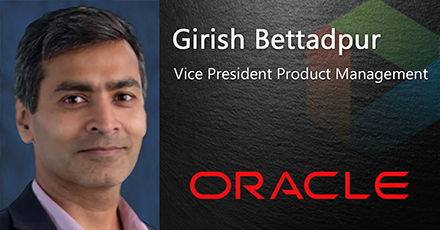
Oracle has been named as a Challenger in the 2021 edition of the Gartner MQ DXP report. What do you think earned Oracle a spot in this year’s Magic Quadrant DXP report?
"Oracle’s DXP platform is covered by Oracle Advertising and Customer Experience (CX), a connected suite of applications that include Oracle Content Management, CX Marketing, CX Commerce, CX Sales, and CX Service. This platform represents almost two decades of consistent intellectual capital accumulation and growth via acquisition and visionary executive leadership, and Oracle has been a leader in the Gartner MQ for WCM report for many years prior to the switch to DXP. We believe we’ve been able to achieve this position due to the following:
- Oracle’s CX platform addresses DX needs across the entire technology stack from infrastructure to middleware, data, content, applications, and verticalized industry solutions. Oracle has thousands of customers for various use cases in varying industries for these offerings and continues to be one of the top choices for customers when they are looking for DXP offerings.
- Oracle’s investment in R&D and infrastructure – Oracle invests over $6B annually in R&D, and the CX platform is able to take advantage of common platform services such as Oracle Cloud Infrastructure, AI and Machine Learning models, and applications such as Oracle Content Management that serves as a universal content hub for consistent brand interactions across all selling channels.
- Oracle Content Management includes a modern, agile, and headless framework that lets businesses balance the needs for both developer freedom and marketing control. With Oracle Content Management, marketers, content authors, and developers can collaborate very effectively due to Oracle Content Management’s user-friendly UI for non-technical users to develop engaging experiences using their preferred front-end technology and still leverage built-in workflows and business user tooling to control content and experiences."
What differentiates the Oracle platform from its competitors?
“Oracle Content Management and Oracle Cx’s differentiators are a key reason for our continued growth in the MQ and push closer towards the leadership position, and these include:
- Integrated CX Suite: Oracle is the only provider in the market that delivers solutions across the stack from infrastructure to cloud applications to verticalized and industry solutions. Additionally, Oracle’s offerings are ready to meet the needs of a modern developer market with headless capabilities while also ensuring that the marketer can design visually rich and interactive experiences in an intuitive and facile interface.
- Front-to-Back Office: We are committed to helping organizations connect all of the data across the front-to-back office. Through native integrations where applicable and through Oracle Integration Cloud (OIC) where not, Oracle Content Management easily integrates with Oracle’s full stack of back office and front office applications allowing customers to easily build content-oriented applications for any experience regardless of persona, be it suppliers, employees, or customers. The solution also integrates with third-party applications such as DropBox, Google Drive, WordPress, Microsoft Office, and others.
- WYSIWYG or Headless: Oracle Content Management is not just API-first, but it goes further to make Headless a joy for developers. With numerous samples to jump-start the development of an application, to coverage across multiple Javascript frameworks, to the upcoming In Context Preview and Headless Orchestration, Oracle is leading the way for Headless, Composable DXP to facilitate pageless experiences for any channel of engagement. Additionally, Oracle Content Management offers simple site-building tools to easily build sites for fast implementation.
- High Availability & Scalability: Oracle Content Management was one of the first Oracle Gen 2 apps and runs on the same High Availability / Security inclusive Architecture of all Gen2 apps providing an additional layer of performance and security."
What did you think about the 'Cautions' the report mentions, and how does Oracle plan to address them?
"The cautions in this MQ evolution were around the fact that Oracle Advertising and CX has many products, that engaging with Oracle can be complex, and the lack of market awareness for Oracle’s DXP offering.
"Oracle’s offerings in the DXP domain are wide, but they are well integrated to ensure a connected experience for the user. This integration is being constantly strengthened and made more seamless through a more cohesive user interface driven by Oracle’s new Redwood theme. In addition, we have numerous options for customers to learn how to use the tool and adopt best practices from peers and partners. We regularly feature product update sessions in our Oracle Cloud Customer Connect community, offer complete documentation online with video tutorials, and provide training and certification courses with Oracle University.
"Additionally, relevant use of Oracle’s strength in ML/AI automates a lot of manual tasks, thus making the integration across the Oracle Advertising and CX suite of applications a benefit for Oracle customers and helps improve efficiency and line of sight into business operations.
From a buying standpoint, Oracle is working on various verticalized solutions and bundles to ensure less burden on the decision-maker and buyer and provide a much more enjoyable buying experience."
What are Oracle's plans for the digital experience space in the coming year?
"Our belief is that the trend towards developer freedom is not going to slow down, and the need for marketers to control the glass is not going away either. Oracle is investing resources to ensure marketers get the best tools to author, assemble, preview, and publish great experiences while developers are able to easily create new and fresh experiences using the front end frameworks of their choice while the back end easily scales to meet the ever-higher demand for performant and secure experiences.
Next-Gen Authoring: We intend to extend the content repository to where authors can create content, whether it is copywriting in MS Word, product catalog management in Excel, or image and template creation in Adobe Creative Cloud, and users will be able to push content directly from these platforms to structured content forms that will make this content discoverable and publishable to any experience instantly.
Seamless Headless Orchestration: Got a Git repo, connect it to Oracle Content Management with a click. Make changes, notify the marketer, preview the new experience, and publish to any serverless experience platform, all in seconds and without the need for any asynchronous collaboration. Oracle believes that collaboration should be part of the tools you use to create and build, not separate from it, and we are investing a lot to make sure marketers and developers can work as one team.
Turnkey Content Applications: Accelerate solutions for your business need, whether it is enablement for sales teams, self-service product catalog management for your vendors, or digital asset and blog management for your content marketers. Oracle is investing in creating turnkey solutions in various areas for different personas, so enterprises can easily deploy these solutions and realize value in a matter of weeks vs. having to wait for years.
Oracle is a data-led company, and Oracle Content Management will benefit from its connectivity with other broad Oracle initiatives that provide significant differentiation. Oracle Unity is a next-generation Customer Data Platform that contains demographic, transactional, and behavioral information and, combined with AI/ML processes; this data can be executed to glean new insights about those customers. Oracle Content Management will be both a producer (click-stream data, content usage, etc.) and consumer of data and insights that are held and determined in Oracle Unity, allowing Oracle Content Management to participate in a major part of Oracle Advertising and CX strategy."
OpenText
OpenText is still a Challenger this year, due in part to its wide customer experience portfolio, support of third-party applications, and strong analytic and business intelligence capabilities. The cautions include a limited focus on specific sectors, a lack of cloud offerings across its portfolio, and a disjointed DXP framework. CMS-Connected was unable to schedule an interview with OpenText in time for article publication.
HCL Software
A new addition to this year’s Quadrant, HCL Digital Experience gets praised for its longstanding history in the industry and strategic partnerships. The vendor’s DXP capabilities can be a good solution for B2B, B2C, and B2E sectors and are proficient in integration, extensibility, and customizations for its platform. The cautions touch the need for an updated DXP codebase, niche DXP capabilities, and less than intuitive interface. CMS-Connected was unable to schedule an interview with HCL Software in time for article publication.
Niche Players (Magnolia, Crownpeak, Squiz, e-Spirit, CoreMedia, Kentico)
Magnolia
Magnolia enters the Niche Quadrant with its Magnolia DX core. The strengths include a “connector-rich framework and modular architecture,” low barriers to entry, and steady growth. Its weaknesses include limited geographic presence outside of Europe and Asia/Pacific, lack of focus on B2E offerings, and it might not appeal to those looking for a “packaged” DXP solution.
Interviewee: Rasmus Skjoldan, Chief Marketing Officer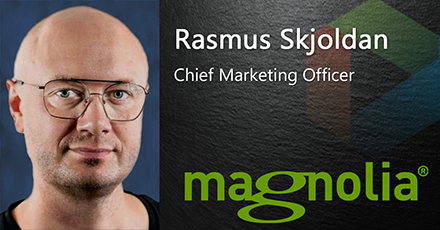
What do you think earned Magnolia a spot in this year’s Magic Quadrant DXP report?
“Composability has been a strategic focus for us for years, long before it was seen as important as it is today. We started building unique and modern DXP capabilities long ago and now clearly see the return – as customers prioritize a modern tech stack above an overcooked feature-bloated monolithic solution. We prioritized capabilities such as integrated user experience across best-of-breed applications – and our Connector Packs that bring true cohesiveness to the DXP. That focus is now being treated seriously in the market, and I think Gartner clearly recognized the strength of our vision.”
What differentiates the Magnolia platform from its competitors?
"We enable customers to launch advanced enterprise-grade DX projects incredibly fast. Time-to-market has become incredibly important, and we consistently get the feedback from new customers migrating off of suite competitors that they can massively improve their time-to-market speed with Magnolia.”
What do you think about the challenges presented in the report? How does Magnolia plan to address them?
“Gartner rightly pointed out that we have lower brand awareness in some markets compared to the old suite players. The modern customer is increasingly self-serving, however, and we’re still plenty present globally to be found by the customers that our solution appeals the most to. They come to us increasingly well-informed about what they’re looking for – so it’s really a strong partnership from the outset. In addition, we’re driving many types of digital campaigns hard, to drive up our awareness in select countries.”
What are Magnolia's plans for the digital experience space in the coming year?
“At the very top of our new website, we write that we’re 'the fastest way to launch digital experiences.' That is not just yet another marketing headline. It’s also a promise to ourselves. To consistently advance capabilities that give customers greater speed. We’ll keep focusing on that across many initiatives.”
Crownpeak
Crownpeak remains in the Niche Player quadrant for another year. Its Digital Experience Management platform strengths include its pricing, cloud-native multi-tenant SaaS DXP offering, and an intuitive, user-friendly UI. The weaknesses include a limited partner ecosystem and marketing effectiveness, and limited scope in its DXP technology solutions.
Interviewee: Lacey Ford, Chief Marketing Officer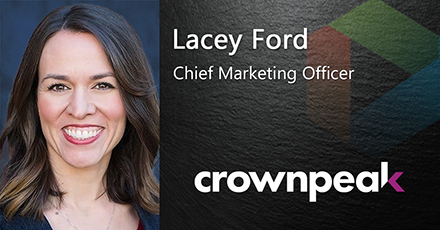
What do you think earned Crownpeak a spot in this year’s Magic Quadrant DXP report?
“Crownpeak provides a popular and proven digital experience platform that’s cloud-native – built for providing scalable, secure, and world-class digital experiences.
"We believe that our best-of-breed capabilities for creating, deploying, and optimizing digital experiences, commitment to product innovation, and track record of customer success were among the strong factors in our inclusion.”
What differentiates the Crownpeak platform from its competitors?
“Crownpeak is the industry’s only truly SaaS-based solution. So when it comes to online content management and digital experience delivery, customers get exceptional speed, performance, and scalability — all without having to worry about their infrastructure.
"We’re also unique in wrapping digital quality, experience optimization and governance, compliance, privacy and consent management, and security into digital experience delivery. With our powerful tools, companies can move faster and execute high-quality digital experiences with more confidence than ever.
"Another differentiator is Crownpeak’s hybrid headless architecture – separating the content management and content presentation/delivery layers and allowing us to publish final code and content to any end-point. Our unique architecture means that Crownpeak has the best of both worlds — the development flexibility of headless systems while also providing the ability for front-end users to make content changes without IT.
"Gartner’s report also praised, in particular, Crownpeak’s UI ('generally regarded as intuitive and easy to use by business users'), our 'cloud-native multi-tenant SaaS DXP' as especially appealing to organizations 'with few IT resources,' and our 'transparent and competitive pricing.'
What do you think about the challenges presented in the report? How does Crownpeak plan to address them?
“Gartner’s report mentioned some challenges facing the DXP industry at large. Chief among them was providing sufficient usability, scalability, and uptime during the pandemic-induced rush to digital. This wasn’t a challenge or obstacle for Crownpeak clients. Like nearly every business at the onset of the pandemic, Crownpeak’s clients ramped up the pace of their online communications, especially through their websites. In fact, the use of Crownpeak for daily website edits reached 8.8x their regular volume (or an increase of 780%) in March of last year. As many companies made and communicated changes daily, there was also a dramatic and unprecedented increase in using Crownpeak to edit and publish on the weekends.
"With Crownpeak, our clients were able to scale digital content and experience delivery easily during that time – to accommodate their own traffic spikes and the surging demand for online channels. Since Crownpeak is a multi-tenant SaaS solution built on AWS to scale elastically, our customers were (and are) able to scale without adding hardware to a data center and didn’t (and don’t) have to worry about their infrastructure or downtime. Customers benefit from fast, secure, and fully managed content delivery.
"We also address other industry challenges cited by Gartner in being:
- Future-proof — Gartner mentions that application leaders must abandon “monolithic technologies that cannot meet market demands.” In contrast, Crownpeak’s composable DXP strategy means organizations are always future-proofed.
- Best-of-breed — Gartner notes that the market continues to see a divide between all-in-suite and platform-oriented DXP approaches, stating, “There is increasing pressure against the suite approach, in favor of a more incremental, best-of-breed approach with a focus on excelling in integrations.” Crownpeak provides the best-of-breed model, being born in the cloud and highly interoperable.
"Crownpeak is also widely recommended by customer review sites; those who use us love us and achieve outstanding results. We also value strong and mutually beneficial relationships with our partners and take time to ensure our customers always have the best possible experience.
"In addition, and excitingly, our recently announced acquisition of fellow digital experience platform provider e-Spirit will bring even more benefits to customers and the market — strengthening our complementary solution sets and expanding our partner ecosystem and geographic and vertical reach. This enables companies everywhere, and in all industries, to deliver high-quality, revenue-boosting digital experiences.”
What are Crownpeak's plans for the digital experience space in the coming year?
“A big priority, of course, following our acquisition of e-Spirit, is integrating e-Spirit within our organization. We’ll also be integrating our solution sets to bring customers the best of both worlds — including our SaaS-based web CMS and aforementioned best-of-breed offerings (with digital quality, governance, and privacy capabilities included in experience delivery), as well as e-Spirit’s content-driven commerce support and AI-powered personalization.
"We’ll also continue to focus on enhancing usability for marketers. As mentioned, Gartner noted that Crownpeak’s UI is 'generally regarded as intuitive and easy to use by business users.'In the year ahead, we’ll continue to make further strides here, investing in additional ways to make Crownpeak even easier to use for non-tech users.”
Squiz
Squiz spends another year in the Niche Player corner. Its strengths include a highly modular platform, good customer relationships, and attractive pricing. Its weaknesses include a narrow focus on specific sectors such as higher education and government sectors, limited geographic presence, and less than stellar performance of their Squiz Experience Cloud. CMS-Connected was unable to schedule an interview with Squiz in time for article publication.
e-Spirit
New to the Quadrant, e-Spirit marks the entry with its FirstSpirit Digital Experience Platform strengths include a solid product strategy, “agile and architecturally flexible” platform, and its hybrid headless building progressive web application toolkit. As indicated by the report, the vendor's weaknesses include their limited geographical availability and slower adoption of cloud strategy.
Interviewee: Michael Gerard, Chief Marketing Officer 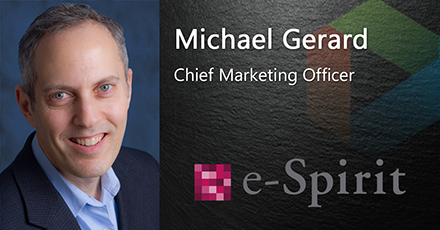
What do you think earned e-Spirit a spot in this year’s Magic Quadrant DXP report?
"We believe that the following three areas in particular earned e-Spirit a spot in this year’s Gartner 2021 Magic Quadrant for Digital Experience Platforms:
- Top customer reviews: Nothing carries more weight than the Voice of the Customer, and e-Spirit is fortunate to have earned the trust and business of many industry-leading customers. e-Spirit is one of the highest scoring DXPs in Gartner Peer Insights for vendors with 10 or more reviews, achieving a score of 4.7 out of 5.0. These peer-driven ratings demonstrate e-Spirit’s ease of use, fast time to market, interoperability in a DX ecosystem, and overall impact for companies wishing to engage, inspire and convert their audience to buyers and fans.
- Flexible architecture: The most successful companies are looking for best in class software vendors that can rapidly and easily interoperate in any DX ecosystem, now and in the future, to deliver compelling experiences to their customers. e-Spirit’s ability to integrate to any other vendor with minimal development effort is recognized by Gartner: As indicated in its Gartner 2021 Magic Quadrant for DXPs, one of e-Spirit’s strengths is 'An agile, architecturally flexible platform with shorter time to value and strong interoperability with adjacent technologies.'
- Ability to deliver personalized multiexperiences: Not only does e-Spirit offer AI-driven personalization, but it’s FirstSpirit DXP is also capable of delivering individualized, connected experiences to any channel or delivery platform with headless CMS capabilities and an out-of-the-box PWA (progressive web application) as needed. Per Gartner, another one of e-Spirit’s strengths is 'A hybrid headless toolkit for building progressive web apps (PWAs) that features content preview and WYSIWYG capabilities improving ease of use and usability for non-technical business users.'
What differentiates the e-Spirit platform from its competitors?
"As one of the only DXP vendors offering a true cloud-based, hybrid headless CMS, e-Spirit is unique from the competition in three key areas:
- Agility: Up to 75%+ faster deployment using the FirstSpirit Experience Accelerator. The FirstSpirit Experience Accelerator shortens implementation time significantly with a ready-to-go progressive web application (PWA) front-end that can be used as a blueprint for custom mobile-first websites and apps. Not just a reference implementation, but a productized, fully maintained, and continuously improved piece of software, the Experience Accelerator enables customers to have immediate access to the capabilities of the FirstSpirit DXP and hybrid headless CMS out of the box. Hybrid headless CMS represents the next generation of the headless CMS and is the holy grail for real-time multi-experience marketing. Why hybrid? Pureplay headless CMS’s lack the scalability and agility of a hybrid CMS. The FirstSpirit hybrid headless CMS allows you to create, manage and accelerate the delivery of personalized content to any channel — and preview and edit the channel experience before it goes live — for immersive digital experiences that inspire customers to action throughout the entire customer journey.
- Empowerment: FirstSpirit is a SaaS-based solution that is easy to use for both non-technical and technical employees, meaning that content can be created and shared quickly and easily.
- Intelligence: AI-powered personalization and predictive analytics deliver unique content that is targeted to specific customer needs, which helps reduce time-to-revenue. e-Spirit’s Intelligent Content Engine technology is based upon deep integration with Dynamic Yield, a Leader in Gartner’s 2020 Magic Quadrant for Personalization Engines. This deep integration has enabled e-Spirit’s B2C and B2B customers across the world to orchestrate personalized digital experiences with ease. Brose, one of the world’s largest suppliers of automotive components with 26,000 employees in over 23 countries and worldwide sales of $7+ billion, uses the FirstSpirit DXP to dynamically personalize their career pages to boost hiring (e.g., 49% increase in IT applicants), a core need to sustain success for such a large, technologically focused company."
What do you think about the challenges presented in the report? How does e-Spirit plan to address them?
"e-Spirit continues to make significant progress in response to the “cautions” mentioned by Gartner, such as continued global expansion, advancement of our out of the box progressive web application (PWA) as part of the FirstSpirit Experience Accelerator for more advanced front end presentation, and even more accelerated adoption of our cloud-based DXP, replacing traditional on-premises CMS solutions.
"That said, the greatest impact on e-Spirit’s future which directly addresses all of the “cautions” indicated by Gartner, is the just-announced acquisition of e-Spirit by Crownpeak.
"This acquisition brings together Crownpeak’s DXP and SaaS-based content management system (CMS) and other best-of-breed offerings – which wrap digital quality, governance and privacy into experience delivery – with e-Spirit’s differentiators, including content-driven commerce experiences and artificial intelligence (AI)-powered personalization.
"The combination of Crownpeak and e-Spirit will create the most agile digital experience platform for brands, regardless of location or vertical, to easily orchestrate digital experiences that build trust and maximize customer lifetime value."
What are e-Spirit's plans for the digital experience space in the coming year?
"e-Spirit is well-positioned for DXP growth in the years to come, based upon our recent acquisition by Crownpeak, as well as having a solid technology roadmap in place that is designed to meet and exceed the needs of the DXP market as indicated by Gartner’s description of e-Spirit: 'A sound product strategy that is aligned accurately with the developments Gartner sees in the DXP market, such as strong cross-channel continuity and personalization."
CoreMedia
CoreMedia remains in a similar position for 2021 as in the previous year. Its CoreMedia Content Cloud’s strengths include a well-developed integration ecosystem — its modular approach to the recent OpenGate Capital’s investment in the company. The report’s cautions touch on its limited geographical presence, which is mostly limited to Europe, and a conservative development strategy and approach, especially compared to other MQ vendors.
Interviewee: Doug Heise, VP of Global Marketing 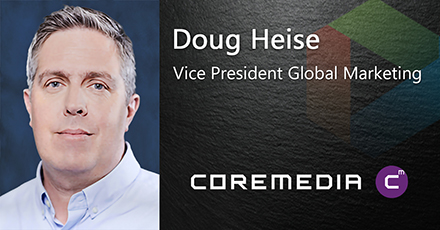
What do you think earned CoreMedia a spot in this year’s Magic Quadrant DXP report?
“Ultimately, it comes down to the fact that we have a proven product and an unblemished track record of helping some of the biggest brands in the world manage their digital transformations. Multi-experience brand orchestration is part of our DNA. And, over the last 25 years, we’ve leveraged this expertise to elevate the brands of organizations as diverse as Deutsche Telekom, Calvin Klein, Continental Tires, UNICEF, and the Australian Broadcasting Corporation. Our customers trust us to support all of their digital initiatives – from corporate intranets and internal DAMs to multi-language websites and online stores – even in-store and out-of-home displays. But we haven’t rested on our laurels – we’re continually working to improve our software offering and our service capabilities. I think those are the qualities and experience that Gartner was looking for when they selected us for this report.”
What differentiates the CoreMedia platform from its competitors?
“CoreMedia Content Cloud excels when it comes to scalability, flexibility, and agility. We don’t force our customers to conform to our way of doing things – or pressure them to adopt a one-size-fits-all approach. We’ve architected our technology to be a composable, event-driven DXP that can fluidly adapt to a customer’s existing business model and software ecosystem. And we help them deliver their digital experiences in a uniquely scalable and highly automatable way. Marketers and eCommerce professionals using CoreMedia can easily transform a single campaign into dozens of different languages and hundreds of channels and launch them in minutes without the need to involve IT or an external agency.
"Finally, we’ve put a lot of effort into making our platform easy to integrate with. Our API-driven approach and portfolio of productized 3rd party integrations reduces time to launch from months to weeks and ensures that our customers’ solutions are secure and future-proof.”
What do you think about the challenges presented in the report? How does CoreMedia you plan to address them?
“Until recently, our growth has been largely organic. This has inevitably dictated both the pace and breadth of our growth and development. We’re extremely proud of what we have been able to achieve through our independent, internal efforts. It has allowed us to cultivate a team of dedicated, passionate innovators that care deeply about our customers. But we also recognize that it has placed some limits on our ability to grow at scale, which is reflected in some of the challenges in the Gartner report. Now, however, with the support of a new team of investors at OpenGate Capital, we have the opportunity to accelerate our product development, expand our market presence, and expand our cloud capabilities without losing sight of our core values and customer-centric approach.”
What are CoreMedia's plans for the digital experience space in the coming year?
“As the world emerges from a year of lockdown and uncertainty, CoreMedia is looking forward to a year of growth and transformation. In many ways, the seeds of this growth were already being sown a year ago, as many customers realized that the pandemic was a warning to double down on their digital initiatives, not retreat from them. In 2021 and beyond, CoreMedia will be following our own advice and doubling down on a range of new initiatives. One focus will be the cultivation and growth of our partner and customer communities with new advisory boards and enablement programs. We will also be investing heavily in product development with the goal of expanding our feature-set, lowering cost and complexity, and expanding our addressable market.”
Kentico
Kentico secures its place once again in the Niche Player corner with its Kentico Xperience solutions. The vendor’s strengths include a solid brand reputation, transparent pricing, and relatively simple deployment, making it attractive for midmarket enterprises. The cautions touch on less than stellar marketing solutions, limited customer journey mapping and customer data management capabilities, and the separation of web content management solutions from its DXP offering.
Interviewee: Dominik Pinter, Managing Director Xperience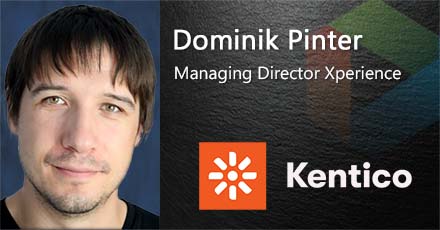
What do you think earned Kentico a spot in this year’s Magic Quadrant DXP report?
“I believe that Gartner recognizes our long-term strong position in the market. They confirm Kentico Xperience represents an attractive offering for the mid-market companies. This is aligned with our strategy for Kentico Xperience. To me, it’s an amazing result, and we’re happy to be recognized among top global companies in this space.“
What differentiates the Kentico platform from its competitors?
“It’s a combination of multiple factors. Firstly, Kentico Xperience is a fully integrated platform. That means that our product is built by a single team and with a single philosophy in mind. We provide a consistent user experience, and all parts of the system work together seamlessly. The platform works end to end. Secondly, total cost of ownership. Our implementation partners are saying it takes less time, money, and hardware to achieve the same business outcome when they compare Kentico Xperience to other leading DXPs they work with. Last but not least, we are easy to do business with. It starts with clear and transparent pricing with no hidden fees. Then, it continues with an easy-to-use product and superior help of our customer success managers, education specialists, and support engineers all the way to a broad network of implementation partners with years of experience and many successful implementations. The outcome is a happy customer who achieved their business goals.”
What do you think about the challenges presented in the report? How does Kentico plan to address them?
“In the last couple of years, we focused on technology transition to Microsoft .NET Core to make Kentico Xperience a future-proof investment for our customers. Now that’s completed, we’re focusing again on the business users – the content teams and digital marketers. This will help us address two cautions mentioned by Gartner. The third one is related to our headless strategy. Today, Kentico Xperience supports headless architecture for content delivery, but we strive for more. We are going to enhance the headless capabilities across the whole platform, providing a complete headless DXP while maintaining the traditional approach for customers who aren’t ready for headless.”
What are Kentico's plans for the digital experience space in the coming year?
“I have already mentioned a stronger focus on the digital marketer. We are introducing more artificial intelligence capabilities such as sentiment analysis or behavior-based content personalization. These items definitely make the daily lives of marketers easier. Also, we are working on the new administration interface to optimize the workflows of digital marketers — from writing articles and creating landing pages to e-mail marketing, easier analysis of customers' funnels and their journeys, automating their routine tasks through our marketing automation, and many others. And to make the life of the marketers absolutely painless, we are going to offer Kentico Xperience in the SaaS model. We believe these enhancements will further strengthen our position as the best choice for the mid-market customers.”
Final Thoughts
This year’s DXP magic quadrant landscape didn’t see a lot of movement. The Leaders held on to their positions, Bloomreach remained the lone Visionary, and HCL Software replaced SAP as a Challenger. As we see in most Magic Quadrants, the most active corner continues to remain the Niche Players’ with newly entrants Magnolia, and the recent Crownpeak acquisition, e-Spirit. The report acknowledges the influence of the COVID-19 pandemic on the DXP landscape, which put pressure on digital transformation for many, both vendors and clients.
Digital experience platforms are more essential than ever, and there is increased demand for modern, composable, best-of-breed solutions. We look forward to seeing the evolution of the DXP industry in the year to come and the vendors' responses to the challenges and opportunities that 2021 will bring their way.
Copyright notices and disclaimers
The contents of this review are protected by international copyright laws, database rights, and other intellectual property rights. The owner of these rights is CMS-Connected Media Corp. All product and company names and logos contained within or appearing on this review are the trademarks, service marks, or trading names of their respective owners. This document may not be copied, reproduced, distributed, or transmitted in any form or by any means without the prior permission of CMS-Connected Media Corp. While reasonable efforts have been made to ensure that the information and content of this review were correct at the date of first publication, neither CMS-Connected Media Corp., nor any person engaged or employed by CMS-Connected Media Corp., accepts any liability for any errors, omissions, or other inaccuracies. Readers should independently verify any facts and figures as no liability can be accepted in this regard — readers assume full responsibility and risk accordingly for their use of such information and content. Any views and opinions expressed in this review by individual authors or contributors are their personal views.

Ellie Somfelean
Ellie is a Reporter and Content Marketer with CMSC Media. She is passionate about social media and digital marketing. She has a vast experience with content creation, influencer marketing and brand promotion.